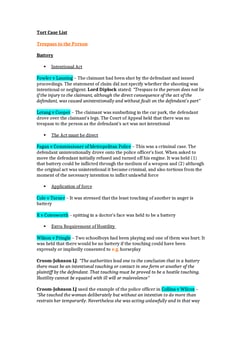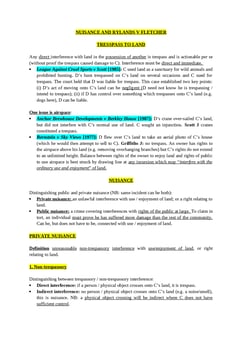Lamb v Camden LBC [1981] QB 625
Judgement for the case Lamb v Camden LBC
Table Of Contents
Plaintiff left their house unoccupied and when Defendant was fixing the water pipes they broke a drain in the house. This caused the foundations damage, caused the walls to crack and the house to subside.
After this, the house was invaded by squatters who caused large amounts of damage.
CA held that the breaking of the pipe did not make it reasonably foreseeable that the squatters would invade.
Denning MR
-
In Dorset Yachts Lord Reid said that where human action occurred between the alleged cause and the consequence/loss, the human action must have been made “very likely” by the original cause for it not to be regarded as an NAI.
This is WRONG because it makes the original party liable beyond all reason e.g. if a borstal boy escaped over the wall, it is very likely that he would steal a car, rob a house, etc. and yet the home office would be liable!
He also says it is irreconcilable with the Wagon Mound (1) and subsequent reasoning that Defendant is liable for whatever can be “reasonably foreseen” as occurring as a result of the breach of contract. (though this test is even wider that Lord Reid’s).
He also rejects mere “reasonable foreseeability” as the test for remoteness as this would extend liability too wide.
The truth is that all these three – duty, remoteness and causation – are all devices by which the courts limit the range of liability for negligence . . . All these devices are useful in their way. But ultimately it is a question of policy for the judges to decide.
In this case it would be bad policy to make the council liable for the squatters’ entrance because homeowners are responsible for their own security and to insure themselves.
Oliver LJ
He explains Lord Reid’s dictum, as trying to explain a point of fact: in cases of 3rd parties inflicting damage, “the immediate cause is known. It is the independent human agency, and one has therefore to ask, on what basis can the act of that person be attributed back to the tortfeasor?”
-
In answer he says that it is logical to attribute back to the tortfeasor those scenarios that are very likely to occur, rather than those merely possible.
(BAD: still doesn’t explain the problems Denning raises or change the fact that, very likely though it may be, a 3rd party still takes a decision to inflict damage independently of the defendant).
-
He applies the “reasonable foreseeability” test to say that the invasion was remote
(He doesn’t apply Lord Reid’s dictum of “very likely” (although this wouldn’t change the result) despite basically agreeing with it).
In obiter he says Lord Reid’s test is good, but he should have gone even further in requiring a high degree of likelihood before the courts will attribute an independent act back to the original tortfeasor.
Watkins LJ
He simply uses the “reasonable foreseeability test”.
He basically denies that Lord Reid meant what he said and was actually applying the “reasonable foreseeability” test of the Wagon Mound (1), even for cases of 3rd party interventions.
RELATED CASES
For Further Study on Lamb v Camden LBC
Need instant answers? Our AI exam tutor is here to help.
Ask questions 🙋 Get answers 📔 It's simple 👁️👄👁️
Our AI is educated by the highest scoring students across all subjects and schools. Join hundreds of your peers today.
Get StartedSimilar Cases
Related Product Samples
These product samples contain the same concepts we cover in this case.
| Tort Law | Nuisance Notes (70 pages) |
| GDL Tort Law | Remoteness Notes (5 pages) |


